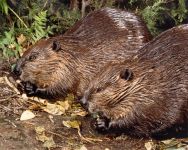


|

|
|
 
|
As with wildlife in general, 'problems' caused by beavers are in the eye of the beholder. In a natural setting, what beavers do from day to day is a critical part of any ecosystem. Occasionally, however, beaver activities come in conflict with what human beings have planned for a particular piece of land. In such situations, there is never a need to resort to lethal means as a method of 'control'.
Points to consider when asked to resolve conflicts:
For more information, you can contact us or other groups knowledgeable about beavers. Listing a group here does not mean that the Refuge necessarily endorses or agrees with the information they provide.
Here are some references for information on solutions or reasons why learning to cohabit with beavers is beneficial to all:
This study demonstrated the cost effectiveness of using preventive measures:Following flow device installations, the estimated cost - benefit ratio was 1 to 8.37, or for every $1 spent, [Virginia Department of Transportation] saved $ 8.37.
A total of 55 beaver conflict sites were studied from 2000 through 2019. This first of its kind study revealed that the sites managed with nonlethal control methods cost significantly less than sites that were managed with beaver removal. In addition, nonlethal control methods provided millions of dollars of ecological services to the town annually that would have been lost with beaver removal.
Ecosystem services may include the abatement of dryland streams (Gibson and Olden, 2014), promotion of waterbird communities (Nummi and Holopainen, 2014), increase in salmon production (Pollock et al., 2004), and the removal of reactive N from the watershed as discussed herein.
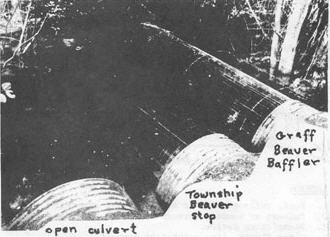
At Unexpected Wildlife Refuge, beavers dammed three four-foot-diameter culverts under Piney Hollow Road, flooding a farmer's field across the road. Township officials decided that the only solution was to get rid of the beavers. We suggested a beaver baffler, to keep the beavers from building in the culverts. The township cooperated by building three five-foot-long cones made of heavy concrete reinforcing mesh, but we felt that the length of these would be inadequate, as beavers might build along and around them.
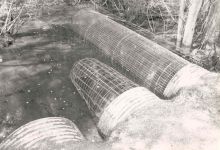
We enlisted the help of Brian Graff of Dolgeville, NY, who had successfully installed a beaver baffler in a road culvert near his homestead, not far from Beaversprite Sanctuary. The Graffs, along with a few other volunteers, helped clear out the culverts and installed a 15-foot-long cylindrical Beaver Baffler with three layers. The core was made of concrete reinforcing mesh wrapped with 1" by 2" mesh fencing wire, around which a larger cylinder of reinforcing mesh was placed, held by wires which kept it separated from the core by a 6" space. One end of this contraption was closed by a piece of reinforcing mesh and the other end forced into the upstream mouth of one of the culverts. We used one of the township stops in another and left the third culvert open so that beavers and other animals could pass up and down stream without having to come out on the road. The downstream ends of the two stopped culverts were capped with reinforcing mesh. All devices were kept firmly in place by metal fence posts driven deep into the bottom mud.
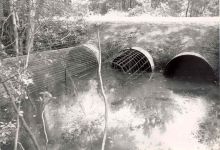
The Beaver Baffler developed by Graff is a modified version of the Beaver Stop™ invented by Neil Thurber of Alberta, Canada.
The installed devices dramatically lowered water level in the neighbor's field, and the beavers have not tried to rebuild around the stops.
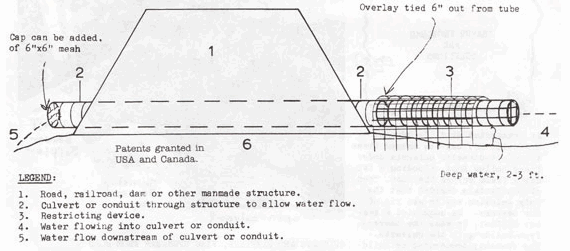
For more information about the Beaver Stop, contact Canada Culvert.
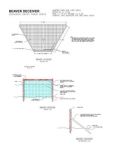
This has apparently been used successfully in Snohomish County, Washington.
According to Sharon Brown of Beavers: Wetlands & Wildlife, "The shape can be rectangular, or trapezoidal, with sides at least twice the width of the culvert or spillway opening. Either metal or wood posts are used with large mesh fencing of 8, 6 or 4 gauge. The smaller the gauge #, the thicker the wire; 8 ga. is easier for beginners. If the stream bottom is muddy, a floor of the same material is laid first to prevent beavers from burrowing underneath the fence." (personal communication, 7 December 2015)
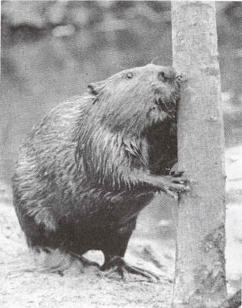
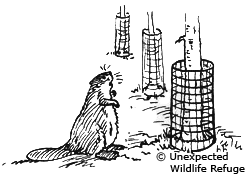
To protect trees from being felled by beavers, there is a simple solution: put cages around the bases. We used cylinders of 2" by 4" by 3' heavy wire fencing. These cages should be large enough in diameter to encircle the trees with at least a 6" space between wire and trunk. A 12" space would be better, as beavers may gnaw between the wires of the mesh. Cut the horizontal wires at one end and next to the vertical wires, and then fashion the cylinder by hooking long ends around the vertical wires. The guards can be removed by merely unhooking the wires.
You can download a sheet containing this information.
This is almost never a satisfactory 'solution' for many reasons:
Here is a limited reference list for the problems of translocation:
From 1994 to 1999 we trapped and relocated 234 Beaver to 14 areas throughout Wyoming to improve riparian habitat and create natural wetlands. We attached radio transmitters to 114 Beaver and subsequently determined movements and mortality of release Beaver...Mortality and emigration (including transmitter failure) accounted for the loss of 30% and 51%, respectively, of telemetered Beaver within 6 months of release. ...2-3.5 year-old Beaver had higher average success (measured in days of occupancy at the release site) than older animals. Animals < 2 years old had 100% mortality and emigration losses within 6 months of release.
I trapped and transported 38 individuals to the nine release sites where dams constructed by beavers would benefit coho salmon productivity. All adult and sub-adult beavers were equipped with tail-mount transmitters. ... All radio-tagged individuals dispersed from their release sites. Survival 16 weeks post-release was 47%. Twelve of the radio-tagged beavers died within 90 days of release. Three cause-specific sources of mortality were identified including predation, natural causes, and human related. Mountain lions (Puma concolor) were responsible for the majority of predation based mortalities. Of the 38 nuisance beavers relocated, only five individuals contributed to the nine dams constructed post-release.